
Carcharhiniformes, the ground sharks, are the largest order of sharks, with over 270 species. They include a number of common types, such as catsharks, swellsharks, and the sandbar shark.
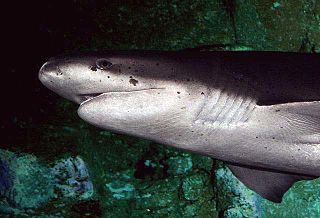
The Hexanchiformes are a primitive order of sharks, that numbering just seven extant species in two families. Fossil sharks that were apparently very similar to modern sevengill species are known from Jurassic specimens.
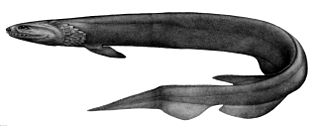
The frilled shark, also known as the lizard shark, is one of the two extant species of shark in the family Chlamydoselachidae. The frilled shark is considered a living fossil, because of its primitive, anguilliform (eel-like) physical traits, such as a dark-brown color, amphistyly, and a 2.0 m (6.6 ft)–long body, which has dorsal, pelvic, and anal fins located towards the tail. The common name, frilled shark, derives from the fringed appearance of the six pairs of gill slits at the shark's throat.

Chlamydoselachidae is a family of primitive deep-sea sharks in the order Hexanchiformes. They are one of only two extant families in the order alongside the cow sharks in the family Hexanchidae, and the only members of the suborder Chlamydoselachoidei.

Chlamydoselachus is a genus of sharks and the sole extant member of the family Chlamydoselachidae, in the order Hexanchiformes. It contains two extant and four extinct species. The most widely known species still surviving is the frilled shark. It is known as a living fossil, along with Chlamydoselachus africana, also known as the southern African frilled shark, which is only found along coastal areas of South Africa. The only two extant species of this genus are deep-sea creatures which are typically weakened in areas closer to the surface. While the two extant species are similar in external appearance, they differ internally.
The shark order Hexanchiformes is often considered the most primitive of extant sharks, since they share some features with Paleozoic and early-Mesozoic shark groups as the Cladoselachiformes. Thus, it is interesting to see how far back the fossil record of this order reaches.

Falcatidae is a family of Paleozoic holocephalians. Members of this family include Falcatus, a small fish from the Bear Gulch Limestone of Montana. The family first appeared around the start of the Carboniferous, and there is some evidence that they survived well into the early Cretaceous, though its putative Cretaceous members were also argued to be more likely neoselachians.
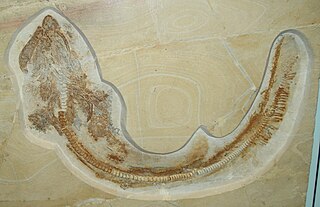
Paraorthacodus is an extinct genus of shark. It a member of the family Paraorthacodontidae, which is either placed in Hexanchiformes or in Synechodontiformes. It is known from over a dozen named species spanning from the Early Jurassic to the Paleocene, or possibly Eocene. Almost all members of the genus are exclusively known from isolated teeth, with the exception of P. jurensis from the Late Jurassic-Early Cretaceous of Europe, which is known from full body fossils from the Late Jurassic of Germany, which suggest that juveniles had a robust body with a round head, while adults had large body sizes with a fusiform profile. There was only a single dorsal fin towards the back of the body without a fin spine. The dentition had teeth with a single large central cusp along with shorter lateral cusplets, which where designed for clutching. The teeth are distinguished from those of Synechodus by the lateral cusplets decreasing in size linearly away from the central cusp rather than exponentially as in Synechodus.
Gladioserratus is an extinct genus of cow shark. It contains three species:

Meristodonoides is an extinct genus of hybodont. The type species is M. rajkovichi, which was originally a species in the genus Hybodus. The species, along with other Hybodus species such as H. butleri and H. montanensis, was reassigned to Meristodonoides by Charlie J. Underwood and Stephen L. Cumbaa in 2010. The species is primarily known from remains from the Cretaceous of North America, spanning from the Aptian/Albian to Maastrichtian, making it one of the last surviving hybodont genera, though records of the genus likely extend back as far as the Late Jurassic, based on an undescribed skeleton from the Tithonian of England, and fragmentary teeth from the Kimmeridgian of Poland, England and Switzerland. Other remains of the genus are known from the Coniacian of England, the Aptian-Albian of France, and the Campanian of European Russia. The morphology of the teeth suggests an adaptation to tearing prey. Fossils from the Western Interior Seaway suggest that it preferred nearshore marine environments, being absent from deeper-water areas, with it likely also being able to tolerate brackish and freshwater conditions.
This list of fossil fish species is a list of taxa of fish that have been described during the year 2012. The list only includes taxa at the level of genus or species.
The Northumberland Formation is a Late Cretaceous (?Campanian-?Maastrichtian)-aged geologic formation in Canada. It belongs to the larger Nanaimo Group. Indeterminate bird and pterosaur fossils have been recovered from the formation, as well as a potential gladius of Eromangateuthis. An extensive diversity of shark teeth is known from the formation; many appear to be closely allied with modern deep-water shark taxa, suggesting a deep-water environment for the formation. The most well-known exposures of the formation are on Hornby Island.
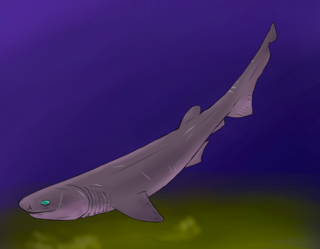
Mcmurdodus is an extinct genus of chondrichthyan from Antarctica and Australia and the sole member of the family Mcmurdodontidae. It contains two extinct species. However, the Australian species M. whitei has been found to be different from the Antarctic type species M. featherensis, and thus M. whitei has been classified into a new genus, Maiseyodus.

Synechodontiformes is an extinct order of prehistoric shark-like cartilaginous fish, known from the Permian to the Paleogene. They are considered to be members of Neoselachii, the group that contains modern sharks and rays.
Notidanodon is an extinct genus of cow shark. Fossils ascribed to this genus are known from the Jurassic and Cretaceous periods. Recently, the genus underwent a major revision and was split into two after the erection of Xampylodon to accommodate the species X. dentatus, X. loozi, and X. brotzeni. The genus is now known only from New Zealand, Antarctica, Africa, and South America.
Adnetoscyllium is an extinct genus of bamboo shark from the Cretaceous period. It is currently monotypic, containing only the species A. angloparisensis. The genus is named for prominent paleoichthyologist, Dr. Sylvain Adnet. The specific epithet refers to the range which is thus far restricted to the Anglo-Paris Basin of France and the United Kingdom.
Hessinodon is an extinct genus of possible kitefin sharks that lived during the Late Cretaceous. It contains one valid species, H. wardi, which is known from four teeth from the Northumberland Formation of British Columbia. Its teeth are most similar to those of modern cookiecutter sharks.
Dykeius is an extinct genus of large shark in the family Chlamydoselachidae. It contains a single known species, D. garethi, from the Late Cretaceous Northumberland Formation of Canada. The genus and species names honor paleontologist Gareth J. Dyke.
Komoksodon is an extinct genus of hexanchiform shark known from the Late Cretaceous to the Paleocene. It is the only member of the monotypic family Komoksodontidae.
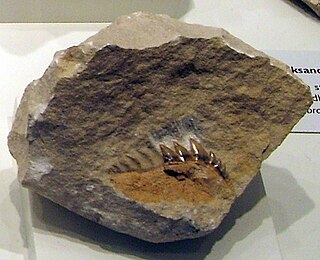
Xampylodon is an extinct genus of cow shark. Fossils assigned to this genus are known from the Late Cretaceous and early Paleocene. Xampylodon was recently erected after a revision on the taxonomy of hexanchid fossil teeth, and includes three species previously included in Notidanodon.










